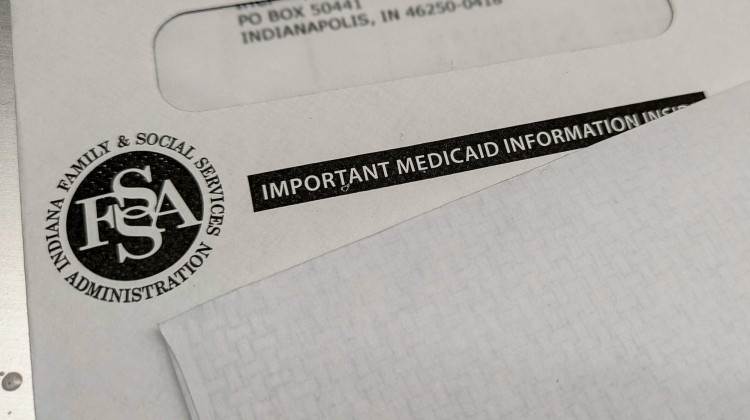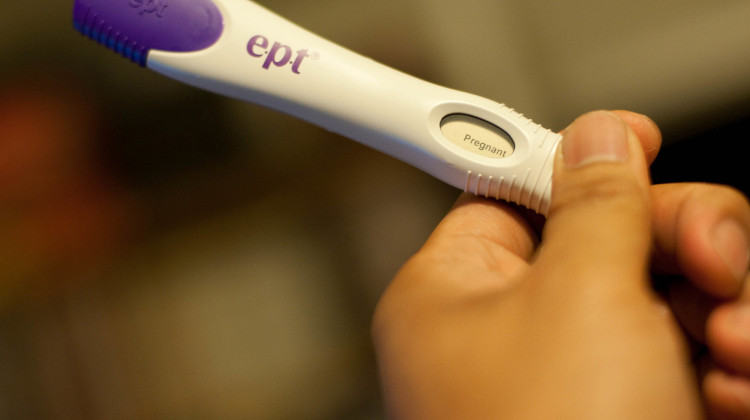
Abortion-rights advocates and anti-abortion protesters faced off in front of the Indiana Statehouse after the 2022 U.S. Supreme Court decision to overturn Roe v. Wade.
Eric Weddle / WFYIA new analysis of national abortion estimates found the number of abortions in 2023 increased slightly compared to the year prior. Telehealth abortions coupled with a number of states passing laws to protect clinicians are likely behind that trend.
Still, in some states with restrictions or bans abortions dropped from several hundred to flatlining, sometimes reaching zero, by the end of last year.
The WeCount report, published by the Society of Family Planning, looked at abortions over 18 months – between April 2022 and December 2023. It reflects abortions provided in a health care setting including in-person and virtual care. It does not reflect abortions done outside of the system, like self-managed abortions.
According to the report, the three months of last year saw between 87,600 and 92,640 monthly abortions.
Remote abortion care
The report also reflects the number of abortions provided under what’s known as shield laws passed in 2023, which protect clinicians from being prosecuted or held liable. These laws passed in several states like New York, Massachusetts, Washington, Vermont and Colorado, to shield clinicians who provide telehealth abortions to people living in states with abortion or telehealth abortion restrictions or bans.
Between October and December 2023, there were an average of nearly 8,000 monthly telehealth abortions provided under shield laws.
And between July and December 2023, over 40,000 people in states with total or 6-week abortion bans and states with restrictions on telehealth abortions have received medication abortion — through a remote consultation with a clinician and mail-out pills — provided under shield laws.
The report authors said this reinforces the fact that “abortion bans do not eliminate the need for abortion care”.
"Even as the total national number of abortions nationally has increased, we can't lose sight of the fact that access to in-person abortion care has virtually disappeared in states where abortion is banned,” said Dr. Alison Norris, WeCount co-chair and professor at the Ohio State University’s College of Public Health. “The loss of clinic-based care — which makes up more than 80% of abortion care — is a devastating loss to access for people across wide swaths of the country.”
According to the report, even without counting the abortions performed under shield laws, there were more abortions provided on average every month in 2023 compared to 2022.
Between October and December 2023, telehealth abortions accounted for 18% to 19% of monthly abortions provided in the U.S. –– a significant increase from years before.
“Access to medication abortion through telehealth continues to play an ever-increasing role in abortion care nationwide — even as the Supreme Court weighs the fate of telehealth abortion care,” said Dr. Ushma Upadhyay, WeCount co-chair and professor at the University of California, San Francisco’s Advancing New Standards in Reproductive Health (ANSIRH).“The need for abortion care across the country demands that providers, advocates, and lawmakers continue to come together to innovate new strategies to help people access abortion care.”
But groups that oppose abortion rights say that lax policies around mailing abortion pills are driving this increase in remote abortions, which they say is reckless and unsafe.
According to medical guidelines, abortion pills are safe to end a pregnancy up to 11 weeks.
But a case, which aims to restrict the use of the drug mifepristone, is awaiting a U.S. Supreme Court decision and could potentially put a wrench in the telehealth abortion landscape by barring providers from mailing the drug and requiring an in-person visit.
State-by-state variation
The state that saw the largest overall surge in abortion volume was Illinois – with more than 35,000 extra abortions over the 18-month period. That is in part due to the fact that Illinois is close to or bordered by states with abortion bans.
In the rest of the Midwest, the monthly number of abortions varied widely by state. The average monthly abortions in Ohio was 2,000, in Kansas it was 1,716 and in Iowa it was 350.
That is contrasted by a steep decrease in the number of monthly abortions provided in states like Indiana, where it dropped from around 500 monthly abortions at the start of 2023 to just 20 in December due the abortion ban, which went into effect in August of last year.
Oklahoma, which has had a total abortion ban for most of the 18-month period, has seen monthly abortions go from around 310 pre-Dobbs to zero between July 2022 and December of last year. Kentucky with a 6-week abortion ban also saw abortions drop from a monthly average of 345 pre-Dobbs to just 16 between July 2022 and December of last year.
Nebraska saw a modest dip in the number of monthly abortions despite enacting a 12-week ban in May 2023. Monthly abortions there dropped from around 320 at the start of last year to between 120 and 230 monthly abortions after the 12-week ban went into effect.
Side Effects Public Media is a health reporting collaboration based at WFYI in Indianapolis. We partner with NPR stations across the Midwest and surrounding areas — including KBIA and KCUR in Missouri, Iowa Public Radio, Ideastream in Ohio and WFPL in Kentucky.
 DONATE
DONATE






 Support WFYI. We can't do it without you.
Support WFYI. We can't do it without you.